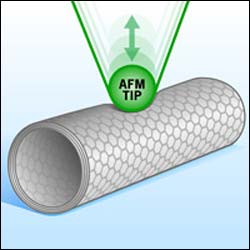Like the Famous Doughboy, Nanotubes Give When Poked

Using an atomic force microscope, researchers prodded the nanotubes to see how much they give.
Smaller, faster computers, bullet proof t-shirts and itty-bitty robots, such are the promises of nanotechnology and the cylinder-shaped collection of carbon molecules known as nanotubes. But in order for these exciting technologies to hit the marketplace (who wouldn’t want an itty-bitty robot), scientists must understand how these miracle-molecules perform under all sorts of conditions. For, without nanoscience, there would be no nanotechnology.
In a recent study, researchers at the Georgia Institute of Technology, along with colleagues from the IBM Watson Research Center and the Ecole Polytechnique Federale de Lausanne in Switzerland, found that while nanotubes are extremely stiff when pulled from the ends, they give when poked in the middle. The larger the radius, the softer they become. The finding, which is important for the development of nanoelectronics, is published in the May 6, 2005 edition of the journal Physical Review Letters.
“We know from previous studies that nanotubes are very stiff in the axial direction (end to end) but very little is known about their radial elasticity, mainly because when you’re working with tubes that small it’s very difficult to poke them without pushing them beyond the point where they will be irremediably damaged,” said Elisa Riedo, assistant professor of physics at Georgia Tech.
Using an atomic force microscope (AFM) and testing it with a tip of 35 nanometers in radius, researchers lightly prodded the nanotubes to measure the elasticity.
“By making a very small indentation in the tubes, we were able to measure the radial elasticity of a number of single and multiwalled carbon nanotubes of different radii. What we found was that as we tested this technique with wider and wider nanotubes, the bigger tubes were much less stiff than the smaller tubes,” said Riedo.
Riedo and colleagues began with a single-walled nanotube with a radius of only 0.2 nanometers and slowly inched, or rather nanometered, their way up to multiwalled nanotubes measuring 12 nanometers in radius. They tested 39 nanotubes in all.
“We started with single-walled nanotubes and then measured tubes with an increasing number of layers, keeping the external radius twice as large as internal radius,” said Riedo. “Our experiments show that for nanotubes with small internal radii, increasing the radii makes them softer. This means that for these tubes, the radial rigidity is controlled by the magnitude of the internal radius, whereas the number of layers plays a minor role.”
But, for the nanotubes with larger radii, the elasticity of the nanotubes is almost constant. This could mean that the softening that occurs as the internal radius of a nanotube is increased, is counterbalanced by the stiffening effect that occurs as the number of layers increases, up to the point at which the nanotube’s properties reach those of graphite, she said.
Understanding just how much these nanotubes of various sizes and layers can bend is an important step in the development of nanoelectronics and the nanowires that carry electrical current through them. Recently, a team of scientists at the University of California, Irvine, demonstrated that transistors made of single-walled nanotubes can operate at much faster speeds than traditional transistors. Knowing just how far these tubes can bend may lead to even more efficient nanowires.
Since the team kept the external radius twice the distance as the tubes’ internal radius in this round of tests, Riedo said the next step is to change this ratio and vary the number of layers, while keeping the internal radius constant and vice-versa to see how these changes affect the tubes’ elastic properties.
Media Contact
More Information:
http://www.icpa.gatech.eduAll latest news from the category: Physics and Astronomy
This area deals with the fundamental laws and building blocks of nature and how they interact, the properties and the behavior of matter, and research into space and time and their structures.
innovations-report provides in-depth reports and articles on subjects such as astrophysics, laser technologies, nuclear, quantum, particle and solid-state physics, nanotechnologies, planetary research and findings (Mars, Venus) and developments related to the Hubble Telescope.
Newest articles

Scientists transform blood into regenerative materials
… paving the way for personalized, blood-based, 3D-printed implants. Scientists have created a new ‘biocooperative’ material based on blood, which has shown to successfully repair bones, paving the way for…

A new experimental infection model in flies
…offers a fast and cost-effective way to test drugs. Researchers at the Germans Trias i Pujol Research Institute and Hospital have reinforced their leading role in infectious disease research by…

Material developed with novel stretching properties
KIT researchers produce metamaterial with different extension and compression properties than conventional materials. With this material, the working group headed by Professor Martin Wegener at KIT’s Institute of Applied Physics…



